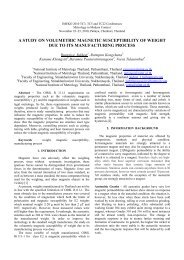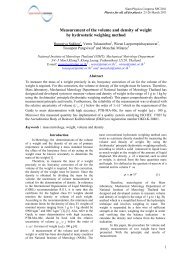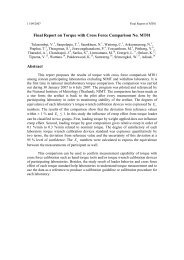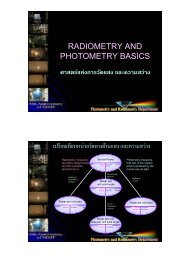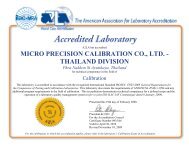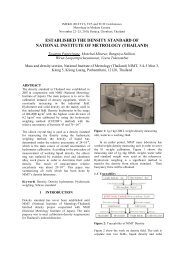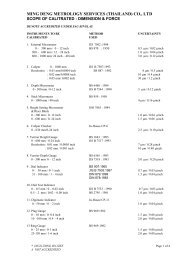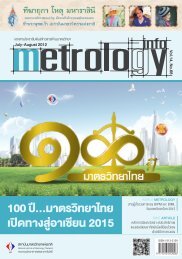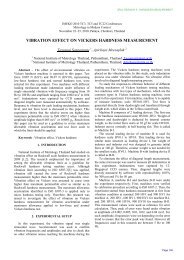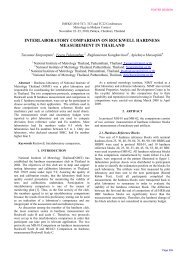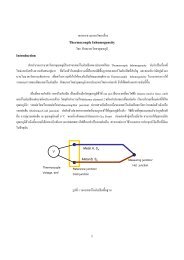A comparative study of acid-extractable and total digestion methods ...
A comparative study of acid-extractable and total digestion methods ...
A comparative study of acid-extractable and total digestion methods ...
Create successful ePaper yourself
Turn your PDF publications into a flip-book with our unique Google optimized e-Paper software.
C. Yafa, J.G. Farmer / Analytica Chimica Acta 557 (2006) 296–303 297Table 1Operating conditions for the Thermo Jarrell Ash IRIS ICP-OES instrumentPower (kW) 1.40Plasma gas flow (L min −1 ) 15.0Auxiliary gas flow (L min −1 ) 0.75Nebuliser gas flow (L min −1 ) 0.75Pump speed (rpm) 15Sample delay (s) 40Rinse time between each sample (s) 40Replicates 3Replicate time (s) 30Stabilisation time (s) 10results from different studies arise from the nature <strong>of</strong> the samplepreparation <strong>methods</strong> adopted.Different research groups have used a variety <strong>of</strong> sample <strong>digestion</strong>schemes, which provide <strong>acid</strong>-<strong>extractable</strong> or <strong>total</strong> elementalconcentrations, without st<strong>and</strong>ardisation <strong>of</strong> <strong>methods</strong>. In general,the <strong>acid</strong>-<strong>extractable</strong> concentrations <strong>of</strong> elements in environmentalmatrices are conventionally defined by procedures involvingextraction with aqua regia or various concentrations <strong>of</strong> nitric<strong>acid</strong> (HNO 3 ) <strong>and</strong> hydrochloric <strong>acid</strong> (HCl) in combination oralone [20]. Procedures for determination <strong>of</strong> the <strong>total</strong> concentrations<strong>of</strong> elements frequently employ mixtures <strong>of</strong> mineral <strong>acid</strong>swith hydr<strong>of</strong>luoric <strong>acid</strong> (HF) or tetrafluoroboric <strong>acid</strong> (HBF 4 ) fordirect wet ashing or dissolution after dry ashing [21–25]. Both<strong>acid</strong>-<strong>extractable</strong> <strong>and</strong> <strong>total</strong> approaches have a number <strong>of</strong> versions,differing not only in the reagents used, but also in the sequence<strong>and</strong> form <strong>of</strong> their use <strong>and</strong> the process parameters, as well as inquantitative parameters, such as the size <strong>of</strong> sample, the concentration<strong>and</strong> amounts <strong>of</strong> reagents <strong>and</strong> the final volume <strong>of</strong> solution.To some extent, this is illustrated by the range <strong>of</strong> preparation<strong>and</strong> analytical procedures used by different laboratories in therecent development <strong>and</strong> certification <strong>of</strong> an ombrotrophic peatbog (low ash) reference material (NIMT/UOE/FM/001) for thedetermination <strong>of</strong> elemental concentrations, in which our laboratoryplayed a central coordinating role (cf. Table 1 in Ref.[26]).Notwithst<strong>and</strong>ing the development <strong>of</strong> this reference material,the lack <strong>of</strong> common procedures for sample preparation hindersnot only the quality assurance <strong>of</strong> the generated analytical data butalso the interpretation <strong>and</strong> comparison <strong>of</strong> peat core metal pr<strong>of</strong>ilesfrom different laboratories in the international community. Forthese reasons <strong>and</strong> at the same time as the reference material wasbeing developed, we undertook a <strong>comparative</strong> <strong>study</strong> <strong>of</strong> <strong>digestion</strong><strong>methods</strong> for preparation <strong>of</strong> peat material for analysis.Our aims were: (i) to develop/optimise <strong>methods</strong> for determination<strong>of</strong> <strong>acid</strong>-<strong>extractable</strong> <strong>and</strong> <strong>total</strong> concentrations <strong>of</strong> inorganicelements using a previously distributed, but ultimately, noncertified,Canadian peat (OGS 1878 P-6) reference material [27]<strong>and</strong> to apply these in (ii) the development <strong>of</strong> the new certifiedreference material for peat (NIMT/UOE/FM/001) [26] <strong>and</strong> (iii)the determination <strong>and</strong> comparison <strong>of</strong> concentration pr<strong>of</strong>iles forvarious elements (some ‘lithogenic’, some ‘pollutant’) in a peatcore from Fl<strong>and</strong>ers Moss, Scotl<strong>and</strong>. As a starting point, we consideredfour different published preparation procedures based onHNO 3 (USEPA 3051) [28], HNO 3 /HCl (USEPA 3051a) [29],aqua regia HNO 3 /HCl (ISO 11466) [30] <strong>and</strong> HNO 3 /HF (USEPA3052) [31].2. Experimental2.1. MaterialsIn the developmental stage <strong>of</strong> the work, a Canadian peat material,OGS 1878 P-6, was used. This material, a Carex (sedge)fen peat (∼20% ash content), was produced by the OntarioGeological Survey in 1982. More recently, as yet uncompletedattempts have been made to develop this as a peat referencematerial for quality control use by laboratories in the internationalpeat bog community. Provisional certified values arisingfrom an inter-laboratory comparison exercise were presented atan international conference in 2000 [27].2.2. Digestion <strong>methods</strong>2.2.1. HNO 3 (adapted USEPA 3051)Conventional HNO 3 <strong>digestion</strong> is commonly employed toachieve <strong>acid</strong>-<strong>extractable</strong> elemental concentrations in geologicalsamples. In this <strong>study</strong>, a modified version <strong>of</strong> the USEPAmethod 3051 protocol [28] was employed for the <strong>digestion</strong><strong>of</strong> peat material, using microwave-assisted HNO 3 <strong>digestion</strong>.The modification, designed to enable some final analyses withICP-MS, where appropriate, entails ashing samples in a mufflefurnace to remove organic material before <strong>digestion</strong>. The overallmethod consisted <strong>of</strong> a representative sample <strong>of</strong> up to 0.25 g(the initial weight) being ashed at 450 ◦ C for 4 h prior to <strong>digestion</strong>in 10 mL concentrated HNO 3 (Aristar, Merck, Poole, UK)in Teflon microwave <strong>digestion</strong> vessels using microwave heatingwith a suitable laboratory microwave system, e.g. MARS 5(CEM, Buckingham, UK). The programme used had the followingfeatures: maximum power 1200 W, 100%, ramp 30 min, hold20 min, 150 PSI, 205 ◦ C. Upon cooling, the solution was filteredthrough Whatman No. 542 filter paper to remove any remainingsolid material. The solution was evaporated to approximately1 mL on a hotplate <strong>and</strong> then made up to 25 mL with 2% (v/v)Aristar HNO 3 prior to analysis by ICP-OES.2.2.2. HNO 3 /HCl (adapted USEPA 3051a)A modified version <strong>of</strong> the USEPA method 3051a protocol forHNO 3 /HCl <strong>digestion</strong> [29] was used in this <strong>study</strong>. As with theconventional HNO 3 <strong>digestion</strong> (Section 2.2.1), a representativesample <strong>of</strong> 0.25 g was ashed at 450 ◦ C for 4 h prior to <strong>digestion</strong>in 9 mL concentrated HNO 3 (Aristar) <strong>and</strong> 3 mL concentratedHCl (Aristar) in the microwave <strong>digestion</strong> system. Thereafter,the procedure was the same as in Section 2.2.1.2.2.3. Aqua regia (HNO 3 /HCl) (ISO 11466)In the absence <strong>of</strong> a microwave <strong>digestion</strong> system, the st<strong>and</strong>ardaqua regia extraction procedure according to ISO St<strong>and</strong>ard11466 is commonly used to achieve <strong>acid</strong>-<strong>extractable</strong> elementalconcentrations [30]. A representative sample <strong>of</strong> 1.5 g peatmaterial was accurately weighed out into a 100 mL conical



